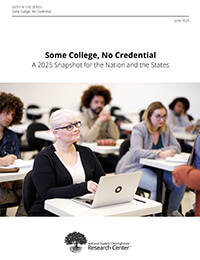Forty-three million Americans have started college but left without earning a credential. That group, known as “some college, no credential,” or SCNC, is larger than the population of California. And it continues to grow.
This recent report from the National Student Clearinghouse shows that between January 2022 and July 2023, 2.1 million people left college, outpacing the number of people who returned or aged out of the working-age group.
We know this group is complicated and nuanced and often misrepresented in the national narrative. In this short video, we break down who makes up the SCNC population in this country and why they’re so important.
More than one million SCNC students re-enrolled in the 2023-24 academic year, which is 66,000 more than the year before. Nearly 5 percent of those who re-enrolled earned a credential within that first year. Every state saw its SCNC population grow, and 42 states plus the District of Columbia also saw increases in re-enrollment.
Community colleges are a central part of this picture. They are the most common last point of enrollment for students who stop out and the most frequent destination for those who return. Primarily online institutions are also playing a larger role. They enroll a significantly higher share of returning students than the share of students who originally left these institutions.
There are encouraging signs on equity, too. Black, Hispanic and Latino, and Native American students are more likely to be part of the SCNC population. At the same time, every racial and ethnic group saw gains in re-enrollment or credential completion. However, gaps remain. White and Asian students who return to college still complete credentials and continue their education at higher rates. These differences point to the need for better student support and targeted action.
More students are returning to college and completing their goals. But millions more are still waiting for the chance to finish what they started. States and institutions can help by streamlining re-entry pathways, recognizing and awarding credit for prior learning, and addressing financial barriers through debt forgiveness or last-dollar programs. Stopping out should not mean giving up. With the right tools and support, more learners can complete their journeys and create brighter futures, for themselves and for the communities around them.

